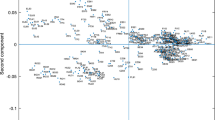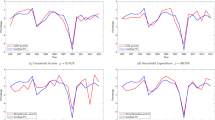Abstract
The multivariate pluriformity and complexity of economic-geographic space (e.g., cities or countries) are reflected in their empirical multidimensional data structure with space–time characteristics. The need to reduce the multiple dimensions of an observation space is present in all social (and other) sciences seeking to identify basic patterns or key relations among critical indicators that characterize economic or social features of the phenomena concerned. For this purpose, multivariate statistics has developed an impressive toolbox, in which traditionally a prominent place is taken by the class of principal component analyses (PCA). This technique dates back to the beginning of the last century and is widely employed in empirical research aiming at reducing complexity in observation spaces toward manageable patterns of a smaller dimensionality. In the present study, we develop and present a new methodological contribution to in the PCA field, by shifting from conventional discrete static data to time-series data approximated by a continuous intertemporal curve reflecting the evolution of the socioeconomic data concerned. In this paper, the statistical foundation of this new approach, called multivariate functional principal component analysis (MFPCA), will be outlined and tested for a multivariate long-range data set on statistical indicators for several countries. The practical validity of the MFPCA method will be demonstrated by means of an application to the evolution of socioeconomic competitiveness (in this paper, we use the WEF definition of competitiveness, which is: “Competitiveness is the set of institutions, policies, and factors that determine the level of productivity of a country” WEF 2015) in different countries of the world, based on official World Economic Forum (WEF) data spanning the period 2008–2015. Our analysis brings to light interesting findings and differences compared to the initial, officially published WEF information.

Source: own compilation

Source: own compilation based on World Economic Forum (WEF) data

Source: own compilation

Source: own compilation

Source: own compilation on basis Global Competitiveness Reports (WEF)

Source: own compilation
Similar content being viewed by others
References
Besse P (1979) Étude descriptive d’un processus: aproximation et interpolation. Ph.D. thesis, Université Paul Sabatier, Toulouse III
Cressie N, Wikle CK (2011) Statistics for spatio-temporal data. Wiley, Hoboken, New York
Fotheringham S, Rogerson P (eds) (1994) Spatial analysis and GIS. Taylor and Francis, London
Górecki T, Krzyśko M, Waszak Ł, Wołyński W (2014) Methods of reducing dimension for functional data. Stat Trans New Ser 15(2):231–242
Górecki T, Krzyśko M, Waszak Ł, Wołyński W (2018) Selected statistical methods of data analysis for multivariate functional data. Stat Papers 59:153–182
Gould PR (1967) On the geographical interpretation of eigenvalues. Trans Inst Br Geogr 42:53–85
Hotelling H (1936) Relation between two sets of variables. Biometrika 28(3/4):321–377
Horváth L, Kokoszka P (2012) Inference for functional data with applications. Springer, Berlin
Jacques J, Preda C (2014) Model-based clustering for multivariate functional data. Comput Stat Data Anal 71:92–106
Palka Z, Ratajczak W, Weltrowska J (2001) Wyznaczanie odległości pomiędzy grafami (Determination of distances between graphs), In: Rogacki H (ed) Koncepcje teoretyczne i metody badań geografii spoŃeczno-ekonomicznej i gospodarki przestrzennej (Theoretical conceptions and research methods of socio-economic geography and the spatial economy). Poznań, pp 147–158 (in Polish)
Pearson K (1901) On lines and planes of closest fit to systems of points in space. Philos Mag 2(11):559–572
Ramsay JO, Silverman BW (2005) Functional data analysis, 2nd edn. Springer, Berlin
Saporta G (1981) Méthodes exploratoires d’analyse de données temporelles. Ph.D. thesis, Université Pierre et Marie Curie, Paris 6
Tinkler KJ (1972) The physical interpretation of eigenfunctions of dichotomous matrices. Trans Inst Br Geogr 55:17–46
Author information
Authors and Affiliations
Corresponding author
Additional information
Publisher's Note
Springer Nature remains neutral with regard to jurisdictional claims in published maps and institutional affiliations.
Rights and permissions
About this article
Cite this article
Krzyśko, M., Nijkamp, P., Ratajczak, W. et al. Multidimensional economic indicators and multivariate functional principal component analysis (MFPCA) in a comparative study of countries’ competitiveness. J Geogr Syst 24, 49–65 (2022). https://doi.org/10.1007/s10109-021-00352-8
Received:
Accepted:
Published:
Issue Date:
DOI: https://doi.org/10.1007/s10109-021-00352-8
Keywords
- Multivariate functional data
- Functional data analysis
- Principal component analysis
- International competitiveness differences




